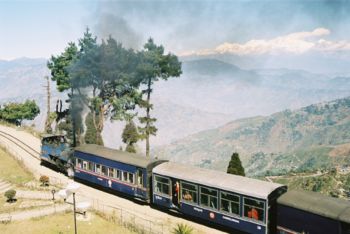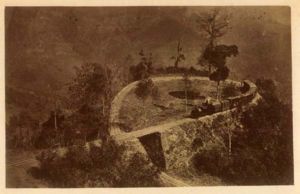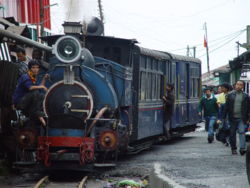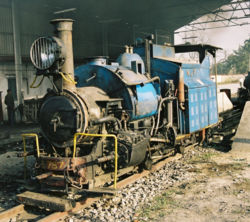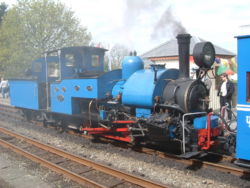Darjeeling Himalayan Railway
The Darjeeling Himalayan Railway, nicknamed the "Toy Train", is a 2 ft (610 mm) gauge narrow-gauge railway from Siliguri to Darjeeling in the Indian state of West Bengal, run by the Indian Railways.[1]
It was built between 1879 and 1881 and is about 86 km long. The elevation level is from about 100 m in Siliguri to about 2200 m in Darjeeling. It is still to this day powered by a steam engine. A modern diesel engine is used for Darjeeling’s mail.
Since 1999 the train has been a World Heritage Site as listed by UNESCO. [2] In 2005, UNESCO added the Nilgiri Mountain Railway as an extension to the original site.
Contents
The Route
- New Jalpaiguri - The railway was extended to the south in 1964 to meet the new Broad gauge to Assam. Where the two met, New Jalpaiguri was created.
- Siliguri Town - Original southern terminus of the line.
- Siliguri Junction - Only became a major station when a new metre gauge line was built to Assam in the early 1950s
- Sukna - This station marks the change in the landscape from the flat plains to the wooded lower slopes of the mountains. The gradient of the railway changes dramatically.
Loop No.1 was located in the woods above Sukna. It was removed after flood damage in 1991. The site is now lost in the forest.
- Rangtong
A short distance above Rangtong, there is a water tank. This was a better position for the tank than in the actual station, both in terms of water supply and distance between other water tanks.
When Loop 2 was removed in 1942, again following flood damage, a new reverse was added. This reverse, No.1, involves the train making the longest of all runs backwards.
Loop No.3 is at Chunbatti. This is now the lowest loop to remain.
Reverses No.2 & 3 are between Chunbatti and Tindharia.
- Tindharia - This is a major station on the line as below the station is the workshops. There is also an office for the engineers and a large locomotive shed, all on a separate site.
Immediately above the station are three sidings; these were used to inspect the carriage while the locomotive was changed, before the train continued towards Darjeeling.
Agony Point is the name given to loop No.4. It comes from the shape of the loop which comes to an apex which is the tightest curve on the line.
- Gayabari
Reverse No.6 is the last reverse on the climb.
- Mahanadi
- Kurseong - There is a shed here and a few sidings adjacent to the main line, but the station proper is a dead end. Up trains must reverse out of the station (across a busy road junction) before they can continue on their climb. It is said that the station was built this way so that the train could enter a secure yard and stay there while the passengers left the train for refreshments.
Above Kurseong station, the railway runs through the bazaar. Trains skirt the front of shops and market stalls on this busy stretch of road.
- Tung
- Dilaram
- Sonada
- Rangbul
- Jor Bungalow
- Ghum - Summit of the line and highest Station in India. Now includes a museum on the first floor of the station building with larger exhibits in the old goods yard.
Batasia Loop
- Darjeeling
The furthest reach of the line is in Darjeeling Bazaar, but this was a goods-only line and is now lost under the road surface and small buildings.
Description of a Journey on the DHR
The Darjeeling Himalayan Railway has long been viewed with affection and enthusiasm by travellers to the region, and the Earl of Ronaldshay gave the following description of a journey in the early 1920s:
"Siliguri is palpably a place of meeting.[.....] The discovery that here the metre gauge system ends and the two foot gauge of the Darjeeling-Himalayan railway begins, confirms what all these things hint at.[....]One steps into a railway carriage which might easily be mistaken for a toy, and the whimsical idea seizes hold of one that one has accidentally stumbled into Lilliput. With a noisy fuss out of all proportion to its size the engine gives a jerk - and starts.[....] No special mechanical device such as a rack is employed - unless, indeed, one can so describe the squat and stolid hill-man who sits perched over the forward buffers of the engine and scatters sand on the rails when the wheels of the engine lose their grip of the metals and race, with the noise of a giant spring running down when the control has been removed. Sometimes we cross our own track after completing the circuit of a cone, at others we zigzag backwards and forwards; but always we climb at a steady gradient - so steady that if one embarks in a trolley at Ghum, the highest point on the line, the initial push supplies all the energy necessary to carry one to the bottom." [1]
The trip up to Darjeeling on the Himalayan Railway has changed little since that time, and continues to delight travellers and rail enthusiasts, so much so that it has its own preservation and support group, the Darjeeling Himalayan Railway Society.
Locomotives
All the steam locomotives currently in use on the railway are of the 'B' Class, a design built between 1889 and 1925. A total of 34 were built but by 2005 only 12 remained on the railway and in use (or under repair).
Locomotive No.787 has been rebuilt with oil firing. This was originally installed to work on the same principle as that used on Nilgiri Mountain Railway No.37395. To operate the oil burner and an electrically driven feed pump, a diesel-powered generator was fitted and to power the braking system, a diesel-powered compressor was fitted. Additionally the locomotive was fitted with a feed water heater. The overall result was a dramatic change in the appearance of the locomotive.
In March 2001, DHR No.794 was transferred to the Matheran Hill Railway to allow a 'Joy Train' (Steam-hauled tourist train) to be operated on that railway. It did not, however, enter service there until May 2002.
Only one DHR steam locomotive has been taken out of India, this is No.778 (originally No.19). After many years out of use in an American museum, it was sold to an enthusiast in the UK and restored to working order. It is now based on a private railway in Oxfordshire but has run on the Ffestiniog Railway
Two diesel locomotives are in use on the Darjeeling Himalayan Railway, No.604 & 605. They are both members of the NDM6 class. Both were originally intended for use on the Matheran Hill Railway and are identical to the four locomotives actually delivered there.
In 1910 the railway purchaced the third Garratt locomotive built, a 0-4-0+0-4-0 placed in the D class.
Darjeeling Himalayan Railway in popular culture
Bollywood:
External links
- Pictures of Darjeeling and the Toy Train
- See the panography at http://www.world-heritage-tour.org/asia/in/darjeeling/ghumStation.html
- Video from onboard the Toy Train
Film
Director Wes Anderson has announced that he will once again be rejoining Owen Wilson to co-direct a movie entitled The Darjeeling Limited. The movie will follow three brothers, (Owen Wilson, Adrien Brody, and Jason Schwartzman), as they travel throughout India aboard the Darjeeling Railway.
References
- ↑ The Earl of Ronaldshay Lands of the Thunderbolt. Sikhim, Chumbi and Bhutan (London: Constable & Company) 1923 pp10-12
Agra Fort | Ajanta Caves | Champaner-Pavagadh Archaeological Park | Chhatrapati Shivaji Terminus | Churches and Convents of Goa | Elephanta Caves | Ellora Caves | Fatehpur Sikri | Great Living Chola Temples | Hampi | Humayun's Tomb | Kaziranga | Keoladeo | Khajuraho | Mahabalipuram | Mahabodhi Temple | Manas Wildlife Sanctuary | Mountain Railways of India | Nanda Devi and Valley of Flowers | Pattadakal | Qutub Minar | Rock Shelters of Bhimbetka | Sanchi | Sun Temple, Konarak | Sundarbans | Taj Mahal
de:Darjeeling Himalayan Railway fr:Darjeeling Himalayan Railway he:מסילת דרג'ילינג ההימלאית nl:Darjeelingspoorweg ja:ダージリン・ヒマラヤ鉄道 sv:Darjeeling Himalayan Railway zh:大吉嶺喜馬拉雅鐵路
